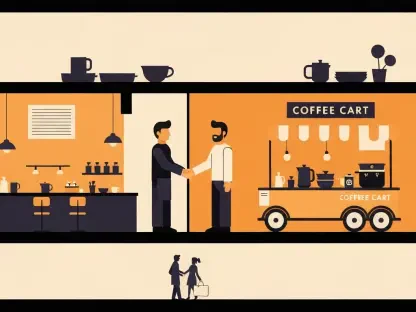In the heart of winter, a bustling restaurant can face an unexpected crisis when a sump pump fails due to freezing temperatures, leading to flooded basements and costly disruptions that threaten business operations. This critical piece of equipment, often tucked away in storage areas or mechanical rooms, is a lifeline for managing water accumulation in high-traffic environments like commercial kitchens. With the restaurant industry already navigating tight margins and seasonal challenges in 2025, protecting these systems from cold-weather damage is not just a maintenance task—it’s a business imperative. This report delves into the vulnerabilities of sump pumps in restaurant settings, explores the causes and risks of freezing, and offers actionable strategies to ensure operational continuity during harsh winter months.
Understanding the Importance of Sump Pump Protection in Restaurants
Sump pumps play an indispensable role in preventing flooding in restaurant basements, storage areas, and mechanical spaces where water accumulation can spell disaster. These systems quietly manage excess water from heavy kitchen usage, cleaning routines, and external sources like rain or snowmelt, keeping critical areas dry and functional. Without proper operation, water can damage inventory, equipment, and infrastructure, leading to significant operational setbacks.
Restaurants face unique vulnerabilities during winter due to their high water usage and specific structural designs. Grease traps, frequent floor washing, and parking lots that channel meltwater toward building foundations increase the strain on sump pumps. When temperatures plummet, these factors compound the risk of freezing, making protection a top priority for maintaining safety and compliance with health regulations.
The stakes are particularly high in an industry where downtime can erode customer trust and revenue. A single flooding incident can disrupt service, spoil perishable goods, and necessitate expensive repairs. Proactive measures to safeguard sump pumps are essential to avoid such scenarios and ensure uninterrupted operations through the coldest months.
Why Sump Pumps Freeze: Causes and Risks
Common Causes of Freezing in Restaurant Settings
Freezing sump pumps often result from environmental and design oversights that are exacerbated in restaurant environments. Uninsulated discharge pipes exposed to frigid air, mechanical rooms that lose heat overnight, and lines with inadequate drainage slopes allow water to sit and turn to ice. These issues are common in older buildings or spaces not originally designed for food service demands.
Restaurant-specific operations add another layer of complexity to the problem. Water-intensive cleaning practices, exterior grease traps prone to overflow, and meltwater from nearby paved areas create a constant influx of liquid that sump pumps must handle. When cold snaps hit, any standing water in the system can freeze, halting functionality at the worst possible moment.
Poor maintenance habits can further aggravate the situation. Neglecting to inspect pipes for blockages or failing to winterize equipment leaves systems vulnerable to temperature drops. Addressing these design and operational factors before winter sets in can significantly reduce the likelihood of a freeze-related failure.
Consequences of a Frozen Sump Pump
When a sump pump freezes, the fallout can be severe and multifaceted for a restaurant. A stalled pump may lead to a burned-out motor as it struggles against ice blockages, while water buildup can flood storage spaces, damaging refrigeration units, electrical systems, and inventory. Such incidents often result in immediate operational halts.
Beyond physical damage, there are regulatory and financial repercussions to consider. Flooding can trigger food-safety violations if water contaminates ingredients or preparation areas, potentially leading to health department citations. The cost of repairs, coupled with lost product and business downtime, can strain budgets, especially for smaller establishments with limited resources.
The ripple effects extend to customer perception and long-term profitability. A temporary closure due to flooding can deter patrons and harm a restaurant’s reputation. Mitigating these risks through preventive care is not just a matter of maintenance but a critical component of business resilience in a competitive industry.
Identifying Risks Before Winter Hits
Spotting potential issues with sump pumps before the onset of freezing weather is a crucial step for restaurant operators. Key warning signs include discharge pipes running along exterior walls or through unheated zones, frost accumulation near outlets, and mechanical rooms that lack adequate warmth during off-hours. These vulnerabilities can often be identified with a thorough property walkthrough.
Attention should also be paid to areas where water tends to pool, such as near grease traps or low-lying parking lots that direct runoff toward the building. If previous winters have revealed ice buildup or drainage problems, those patterns are likely to repeat without intervention. Early detection of such risks allows for timely corrective actions.
Scheduling a professional winterization inspection can provide deeper insights into system health. This process can uncover hidden flaws, like deteriorating check valves or insufficient pipe insulation, before they escalate into emergencies. Taking these proactive steps ensures that potential weaknesses are addressed well in advance of critical temperature drops.
Step-by-Step Guide to Prevent Sump Pump Freezing
Optimizing Discharge Line Setup
Ensuring proper drainage is fundamental to preventing sump pump freeze-ups. Discharge lines should maintain a consistent downward slope of at least a quarter-inch per foot to prevent water from pooling and freezing inside. A thorough check of the line’s angle can reveal whether adjustments are needed to facilitate complete drainage.
Extending the discharge outlet away from high-risk areas is another effective measure. Directing water far from walkways, grease trap zones, or building foundations reduces the chance of refreezing near critical infrastructure. Using freeze-resistant hoses or larger-diameter pipes can further enhance the system’s ability to handle cold conditions.
These modifications, while simple, can make a substantial difference in maintaining pump functionality. Regular assessments of the discharge setup, especially before the winter season, help ensure that water is efficiently moved away from the property, minimizing the risk of ice-related blockages.
Insulating and Heating Solutions
Protecting exposed components from freezing temperatures is a practical and accessible solution for restaurants. Foam insulation sleeves can be applied to discharge pipes that run through cold or exterior spaces, creating a barrier against subzero air. This low-cost option is widely available and easy to install.
For regions with extreme winters, additional measures like heat tape can provide active warmth to vulnerable pipes. In spaces housing the sump pump itself, such as unheated basements, insulating walls or introducing a small, safely operated heater can maintain a stable temperature. These steps prevent the pump and its components from seizing up during cold snaps.
Balancing insulation with proper ventilation is important to avoid moisture buildup, which can lead to other issues like mold. By combining these protective strategies, restaurant operators can create a robust defense against freezing, ensuring the pump remains operational even in harsh weather.
Pre-Winter Testing and Maintenance
Testing the sump pump before the first freeze is a critical preparatory step. Pouring a bucket of water into the pit allows operators to verify that the pump activates, runs without strain, and expels water effectively. This simple test can reveal operational hiccups that need immediate attention.
Inspecting the check valve during this process is equally important. A malfunctioning valve can allow water to flow back into the pit, where it may freeze and obstruct the system. Replacing or repairing faulty components at this stage prevents potential failures during peak winter conditions.
Routine maintenance, such as clearing debris from the pit and ensuring electrical connections are secure, rounds out pre-winter preparations. Addressing these elements early establishes a reliable baseline for the system’s performance, reducing the likelihood of unexpected breakdowns when temperatures drop.
Addressing Power Failures and Winter Storms
Winter storms often bring power outages, rendering even well-maintained sump pumps ineffective without electricity. Restaurants, especially those with critical storage areas below ground level, face heightened risks during such events. A sudden loss of power can lead to rapid water accumulation if the pump cannot operate.
Investing in backup solutions is a prudent strategy to mitigate this vulnerability. Battery backup systems can keep pumps running for several hours during outages, while generators tied to essential circuits offer longer-term protection. These tools are particularly vital for establishments that cannot afford downtime or inventory loss.
Adding water-level alarms or smart monitoring devices enhances off-hours protection. These systems can send alerts via text or email if water rises or the pump fails, allowing for swift response even when staff are not on-site. Such technologies provide an extra layer of security against the unpredictability of winter weather.
Ongoing Maintenance and Staff Training
Consistent care throughout the winter months is necessary to keep sump pumps in top condition. Monthly testing, especially during the colder period from November to March, helps confirm that the system remains functional under real-world conditions. This regular attention can catch minor issues before they escalate.
Annual professional inspections offer a deeper evaluation of the pump’s health, identifying wear and tear that might not be apparent during routine checks. Maintaining detailed logs of all maintenance activities supports compliance with insurance requirements and health inspections, while also providing a record for future reference.
Equipping staff with basic knowledge is another key aspect of ongoing care. Training managers and kitchen personnel to recognize warning signs—such as unusual pump noises or water pooling near the pit—ensures early detection of problems. Empowering the team to act as a first line of defense strengthens overall system reliability.
Final Thoughts on Winterizing Restaurant Sump Pumps
Reflecting on the insights gathered, it becomes evident that proactive sump pump protection is a cornerstone of restaurant resilience during past winters. The risks of freezing, compounded by power outages and operational demands, pose significant threats to business continuity. Detailed strategies, from insulating discharge lines to implementing backup power, prove effective in averting costly disruptions.
Looking ahead, restaurant operators are encouraged to prioritize immediate actions like system testing and staff training to fortify their defenses. Exploring advanced monitoring technologies offers a promising avenue for enhancing off-hours protection. By embedding these practices into seasonal planning, businesses can navigate future winters with greater confidence and operational stability.









